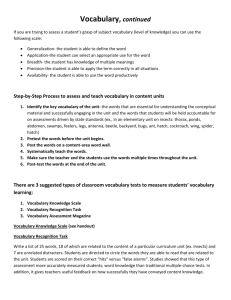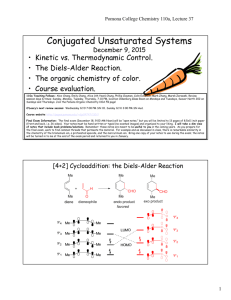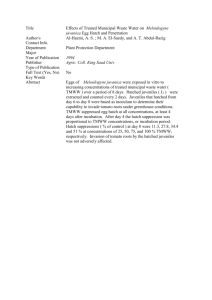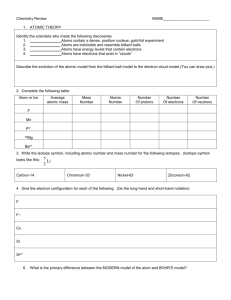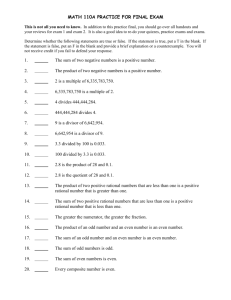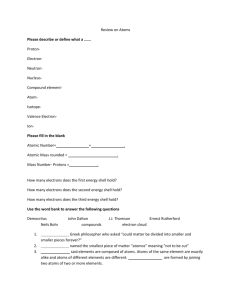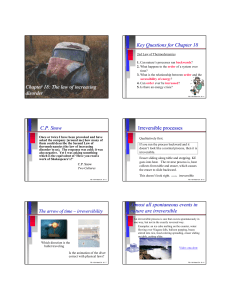On to Chemistry John Dalton proposed the atomic theory (1803
advertisement
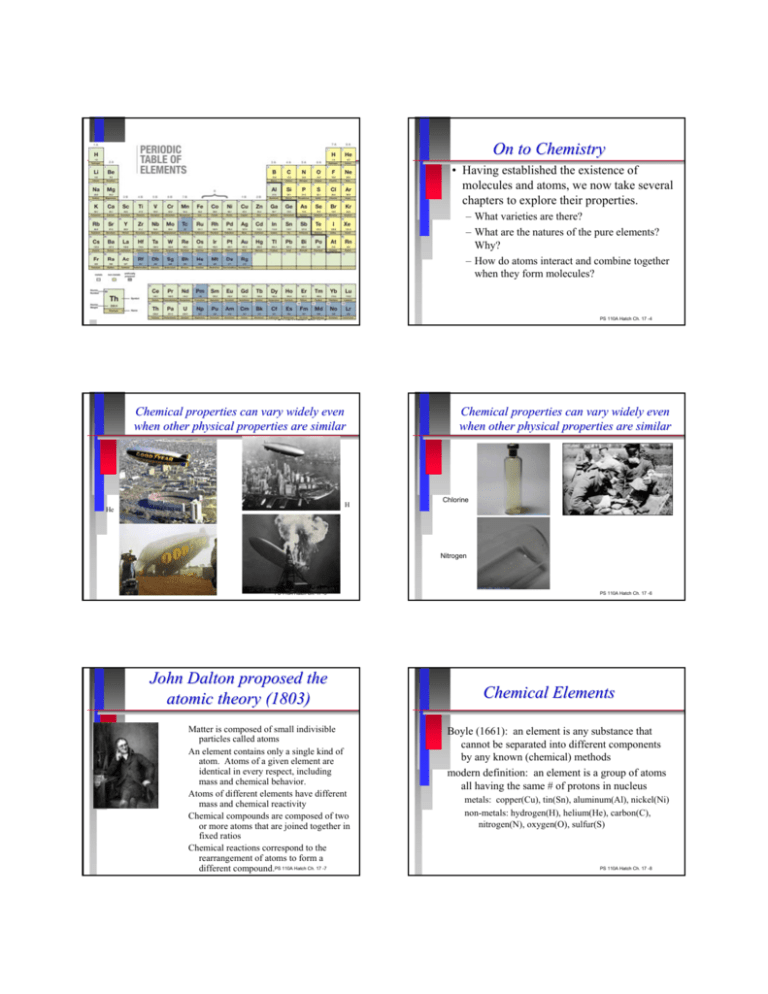
On to Chemistry • Having established the existence of molecules and atoms, we now take several chapters to explore their properties. – What varieties are there? – What are the natures of the pure elements? Why? – How do atoms interact and combine together when they form molecules? PS 110A Hatch Ch. 17 -3 PS 110A Hatch Ch. 17 -4 Chemical properties can vary widely even when other physical properties are similar H He Chemical properties can vary widely even when other physical properties are similar Chlorine Nitrogen PS 110A Hatch Ch. 17 -5 John Dalton proposed the atomic theory (1803) Matter is composed of small indivisible particles called atoms An element contains only a single kind of atom. Atoms of a given element are identical in every respect, including mass and chemical behavior. Atoms of different elements have different mass and chemical reactivity Chemical compounds are composed of two or more atoms that are joined together in fixed ratios Chemical reactions correspond to the rearrangement of atoms to form a different compound.PS 110A Hatch Ch. 17 -7 PS 110A Hatch Ch. 17 -6 Chemical Elements Boyle (1661): an element is any substance that cannot be separated into different components by any known (chemical) methods modern definition: an element is a group of atoms all having the same # of protons in nucleus metals: copper(Cu), tin(Sn), aluminum(Al), nickel(Ni) non-metals: hydrogen(H), helium(He), carbon(C), nitrogen(N), oxygen(O), sulfur(S) PS 110A Hatch Ch. 17 -8 Designating a Specific Atom Mass number Atomic number Al 27 13 3+ Ionic state Early work led to the law of constant composition: Compounds contain a fixed definite proportion of the elements. Chemical symbol Atomic number = number of protons. Mass number = number of protons and neutrons Ionic state = total charge of atom = the number of missing (or added) electrons. atomic weight (atomic mass): the relative mass of naturally occurring atoms of an element compared to carbon-12 atoms which have arbitrarily been given a mass of twelve (often called atomic mass units) PS 110A Hatch Ch. 17 -9 Example: Water By mass: 2 amu of hydrogen for 16 amu of oxygen An oxygen is 16 times more massive than a single hydrogen atom, so we have two hydrogen atoms per oxygen PS 110A Hatch Ch. 17 -10 Arrangement in the periodic table Mendeleev According to atomic number, not atomic weight (27Co, 28Ni) (transparency) Similar chemical properties in same column Dimitri Ivanovich Mendeleev ordered the elements by atomic weight (mass number) and established that there were reoccurring patterns in the ways that elements combined with other elements. But the first attempt had a few problems. Order the elements by atomic number and the periodicity is PS 110A Hatch Ch. 17 -11 perfect. The wave model and the periodic chart To understand the main features of the periodic table we must use the wave model. It explains Atomic diameters Periodicities The octet rule for covalent bonding Molecular shapes PS 110A Hatch Ch. 17 -13 Properties change across same row PS 110A Hatch Ch. 17 -12 Why the periodicity? ☺ The chemical properties of the elements are governed by their electrons. ☺ The number of electrons in a neutral atom is given by the atomic number. ☺ The chemical properties are governed mostly by the nature of the valence (outermost) electrons; i.e. the valence electrons’ energy shells and subshells (arising from the wave model of the atom). ☺ Elements in a family have same number and orbital type of valence electrons & same number of unfilled states in their outermost shell ☺ Moving across a particular row corresponds to gradually filling up a particular shell. PS 110A Hatch Ch. 17 -14 Expected Filling order of States Filling sequence (Periodic Table transparency) - lowest energy orbitals fill first 4S 4P 3S 3P 2S 2P 4F 4D 3D E 1S Notice what happens to the 1s shell! PS 110A Hatch Ch. 17 -15 PS 110A Hatch Ch. 17 -16 Filling order of Electron States Filling Orbitals (Periodic Table transparency) • At the third shell elements start filling higher shell before finishing lower shells – see K and Ca, added 4s before the 3d orbitals – then from Sc to Zn the 3d orbitals are filled • The s and p orbitals strongly determine chemical behavior, s on the left of table and p on the right. transparency of filled levels •Orbitals fill the lowest energy first. However, this does not always mean that the lowest shell is completely filled before electrons begin filling orbitals of the next shell. •valence electrons: the electrons in the outermost occupied shell (the outside shell is often not completely filled). PS 110A Hatch Ch. 17 -17 PS 110A Hatch Ch. 17 -18 Energy Well Orbitals of Valence Electrons P2: Which element is it? What orbital type is its valence electron(s)? etc 3 Filled shell 2 s f d p 2 14 10 6 PS 110A Hatch Ch. 17 -19 p s p s Energy 1 Shells Filled shell s Orbital sets PS 110A Hatch Ch. 17 -20 The elements group together in families of similar chemical properties. The elements group together in families of similar chemical properties. At the left of the periodic table are the alkalai metals: Lithium Li, Sodium Na, Potassium K, etc. They have a single S valence electron which is easily lost. All react energetically with water. At the right of the table are the noble gasses: Helium He, Neon Ne, Argon Ar, etc. Have filled shells. These do not easily combine with other elements. Na Rb K Cs Video: alkalai metals PS 110A Hatch Ch. 17 -21 The elements group together in families of similar chemical properties. The second column from the right is the halogens: Flourine F, Chlorine Cl, Bromine Br, etc. Need only one electron to fill shell. Highly reactive. All form salt compounds PS 110A Hatch Ch. 17 -23 smaller PS 110A Hatch Ch. 17 -22 The “A” Columns •These columns represent filling the S and P shells. •These two outer valence shells are the primary determiner of chemical behavior. •As we move from Sc to Zn the 3d orbitals are filled. The “B” columns of the table. PS 110A Hatch Ch. 17 -24 Sizes (radius in pm) Periodic Trends: P3: Which family smaller Video: noble gasses appears as the peaks in the atomic size plot? Transparency PS 110A Hatch Ch. 17 -25 Atomic Diameters Atomic diameters increase suddenly when the new electron is in the next shell. As you move along the row, the outer electrons of elements have their electrons in the same shell; they fill different orbitals, but the diameters of orbitals in the same shell are comparable. However, more protons pulling on more electrons tends to squeeze the electron probability clouds in closer to the nucleus, decreasing the diameter. PS 110A Hatch Ch. 17 -26 Ionization energy: energy required to completely remove an outermost electron from an atom Ionization Energy freedom etc 3 2 1 Shells d p s p s elements with ionization energies less than 8 electron volts are metals (electrons not tightly bound) shiny, malleable, solid, good conductors, chemically active Ionization Energy elements with ionization energies greater than 10 electron volts are nonmetals s Orbital sets missing at least one of the properties of metals PS 110A Hatch Ch. 17 -27 PS 110A Hatch Ch. 17 -28 Ionization Energies Ion. Energy Ion. Energy Note: in same family Ionization Energies: General trends P4: Element 118 will be discovered. How does its ionization energy compare with Radium (Ra)? ~5 ev PS 110A Hatch Ch. 17 -29 Familiarity PS 110A Hatch Ch. 17 -30 Regularities Alkali Metals (column IA) -single s electron, easily lost -very reactive -ionization energy low PS 110A Hatch Ch. 17 -31 P5: Why does the ionization energy of the valence electron in the metals decrease as you go down the column? (see filling sequence transparency) PS 110A Hatch Ch. 17 -32 Regularities Regularities Halogens (VIIA) Inert gases (VIIIA) -filled shells -difficult to extract electrons -not reactive -high ionization energies -single electron to fill shell -very reactive -grab an electron to fill the shell -give off energy when they grab electron PS 110A Hatch Ch. 17 -33 Group Characteristics Metals on left Non-metals on right Noble gases valence electrons same for all members of family Video: fluorine reactions PS 110A Hatch Ch. 17 -35 As the elements react: • produce molecules and “compounds” • formula of the compound shows how many atoms of each element are in the compound (or how many dozen, or how many moles) PS 110A Hatch Ch. 17 -37 PS 110A Hatch Ch. 17 -34 Mole like the word “dozen” 12 a little larger number mole 6 × 1023 “Avogadro’s Number” Number of molecules or atoms or donuts Why such an unusual number? Just the right number of 12C atoms to weigh 12 g PS 110A Hatch Ch. 17 -36 Triumphs of the Periodic Table Predicted the existence of then undiscovered elements and what their chemical properties would be. Gave simplicity and order to chemistry. Firmly established the existence of atoms. Verified the wave model of the atom. PS 110A Hatch Ch. 17 -38 P6: Which of the following elements do you expect to be chemically most similar to Fluorine a) b) c) d) Oxygen Nitrogen Helium Bromine Neon Sodium Oxygen Nitrogen PS 110A Hatch Ch. 17 -39 Chemical Elements ~ 92 natural elements today mass number ionization number the number of nucleons in the atom tells the number of excess or deficient electrons (charge on atom) 2+ 4 He 2 atomic number the number of protons in the atom P7: Which of the following do you expect to have the largest ionization energy? alpha particle PS 110A Hatch Ch. 17 -41 PS 110A Hatch Ch. 17 -40
